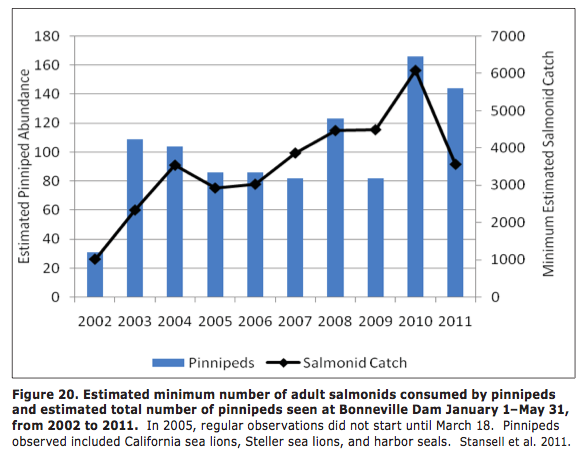forum
library
tutorial
contact

Sea Lions Leave Bonneville Dam;
Impact Well Below High Predation Years
by Staff
Columbia Basin Bulletin, June 1, 2014
|
the film forum library tutorial contact |

|
Sea Lions Leave Bonneville Dam;
by Staff
|
 California and Steller sea lions that have in recent years congregated in springtime below the Columbia River's Bonneville Dam to prey on passing salmon and steelhead, as well as white sturgeon and other fish species, have for the most part moved on to other business, according to U.S. Army Corp of Engineers researchers studying pinniped impacts on protected fish stocks.
California and Steller sea lions that have in recent years congregated in springtime below the Columbia River's Bonneville Dam to prey on passing salmon and steelhead, as well as white sturgeon and other fish species, have for the most part moved on to other business, according to U.S. Army Corp of Engineers researchers studying pinniped impacts on protected fish stocks.
"Sea lions have finally departed Bonneville (except for the occasional straggler)," according to Robert Stansell, who leads the Corps research team. The almost entirely male sea lion contingent is known to forage up and down the coast between early summer breeding seasons on island off the coast of Southern California and in Mexico. Some of the big marine mammals have in recent years taken advantage of timing linked to spawner returns, and followed the salmon up the Columbia.
Pinniped abundance below the dam has dropped off the past few weeks to only one or two visitors present each day. Steller sea lion numbers dropped to zero most days last week and the big marine mammals have disappeared from Bonneville for the most part, according to a May 29 research prepared by the Corps. The average number of Stellers seen at the dam each day is down from the past few years.
A total of about 80 different California sea lions have been seen at Bonneville so far this year, the most since a tally of 89 in 2010. At least 25 of this year's CSL visitors had been spotted at the dam in previous years.
"This is similar to 2010, when more 'new' CSL were seen at the dam than returning individuals. A maximum of 27 CSL on any one day was observed this year."
The toll taken by the big predators has been relatively modest, given that a relatively high number of sea lions visited the dam this year, and the fact that this year's salmon run is larger than average to provide a big prey base. The fish count total has included 207,732 Chinook and 5,469 steelhead total from Jan. 1 through May 28, the largest since 2011.
Total salmonid passage to date is higher than the average for the past 10 years by about 60,000, according to the Corps bi-weekly research report.

"Total salmonid catch through May 28 (3,450 expanded by interpolating for weekends) looks like it will make it higher than the past two to three years, but nowhere near as high as the 2008-2010 years predation" when the salmonid consumption estimate ranged from 4,466 to 6,081.
The largest bite taken by marine mammals at Bonneville was in 2007 when only 88,474 salmon and steelhead passed the dam and sea lions claimed 3,859 fish, which was 4.2 percent of that year's run.
Of the salmon take actually observed this y ear taken by marine mammals (not the expanded total), 2,398 made a meal for California sea lions and 923 were munched by Stellers. The ratio respectively for steelhead was 47-56.
The estimated sturgeon catch this year (expanded for weekends only) is the lowest since the researchers began recording it in 2006. The observed take was 79, all but one by Steller sea lions.
The states of Oregon and Washington this year continued their springtime efforts to trap and remove California sea lions that have been known to prey on salmon and steelhead, which include stocks that are protected under the Endangered Species Act. The program resulted in the removal this year of 15 animals. Another 21 California sea lions were trapped, branded and released, which is twice the number ever trapped and branded at the dam. The animals are branded so they can be identified for research purposes.
The state trapping ended May 15 as few sea lions were present and those that were present did not appear to be using the traps.
Related Pages:
Predators' Toll Below Bonneville Dips; Stellers Take Lions' Share for First Time in Study History by Staff, Columbia Basin Bulletin, 10/12/12
learn more on topics covered in the film
see the video
read the script
learn the songs
discussion forum
